中国传统文化(中英对照)
中国传统文化中英文对照
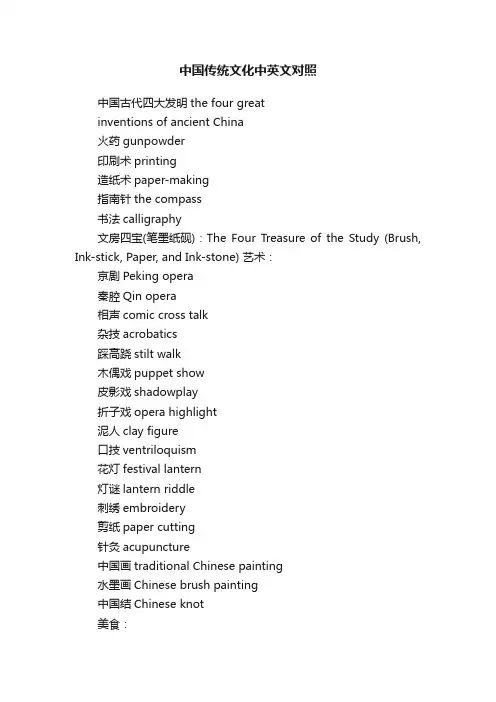
中国传统文化中英文对照中国古代四大发明the four greatinventions of ancient China火药gunpowder印刷术printing造纸术paper-making指南针the compass书法calligraphy文房四宝(笔墨纸砚):The Four Treasure of the Study (Brush, Ink-stick, Paper, and Ink-stone) 艺术:京剧Peking opera秦腔Qin opera相声comic cross talk杂技acrobatics踩高跷stilt walk木偶戏puppet show皮影戏shadowplay折子戏opera highlight泥人clay figure口技ventriloquism花灯festival lantern灯谜lantern riddle刺绣embroidery剪纸paper cutting针灸acupuncture中国画traditional Chinese painting水墨画Chinese brush painting中国结Chinese knot美食:小吃摊snack bar/snack stand月饼moon cake年糕rice cake油条deep-fried dough sticks豆浆soybean milk馒头steamed buns花卷steamed twisted rolls包子steamed stuffed buns拉面hand-stretched noodles馄饨wonton (dumplings in soup)豆腐tofu; bean curd麻花fried dough twist蛋炒饭fried rice with egg节日:春节:the Spring Festival元宵节:the Lantern Festival清明节:the Tomb-sweeping Day端午节:the Dragon-boat Festival中秋节:the Mid-autumn Day重阳节:the Double-ninth Day七夕节:the Double-seventh Day名著:《大学》The Great Learning《中庸》The Doctrine of the Mean 《论语》The Analects of Confucius 《孟子》The Mencius《孙子兵法》The Art of War《三国演义》Three Kingdoms《西游记》Journey to the West《红楼梦》Dream of the Red Mansions《水浒传》Heroes of the Marshes《山海经》The Classic of Mountains and Rivers 《资治通鉴》History as a Mirror《春秋》The Spring and Autumn Annals《史记》Historical Records《诗经》The Book of Songs《易经》The Book of Changes《礼记》The Book of Rites《三字经》Three-character Scriptures旅游景点:秦始皇陵the Mausoleum of Emperor Qinshihuang 兵马俑Terracotta Warriors and Horses大雁塔Big Wild Goose Pagoda丝绸之路the Silk Road敦煌莫高窟Mogao Grottoes华清池Huaqing Hot Springs五台山Wutai Mountain九华山Jiuhua Mountain蛾眉山Mount Emei泰山Mount Tai黄山Mount Huangshan; the YellowMountain故宫the Imperial Palace天坛the Temple of Heaven苏州园林Suzhou gardens西湖West Lake九寨沟Jiuzhaigou Valley日月潭Sun Moon Lake布达拉宫Potala Palace。
中国传统文化词汇
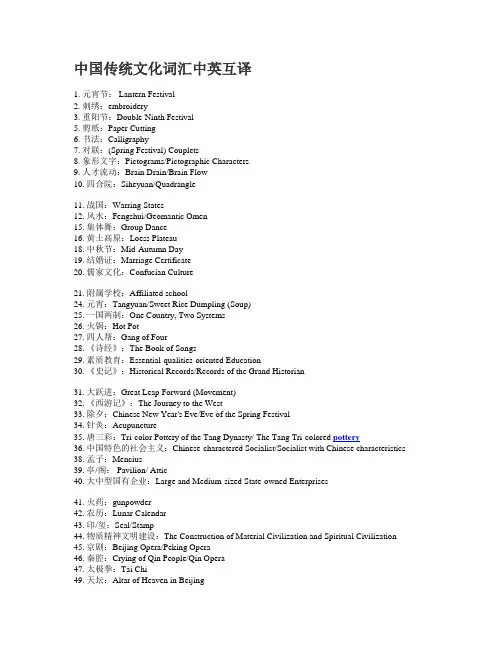
中国传统文化词汇中英互译1. 元宵节: Lantern Festival2. 刺绣:embroidery3. 重阳节:Double-Ninth Festival5. 剪纸:Paper Cutting6. 书法:Calligraphy7. 对联:(Spring Festival) Couplets8. 象形文字:Pictograms/Pictographic Characters9. 人才流动:Brain Drain/Brain Flow10. 四合院:Siheyuan/Quadrangle11. 战国:Warring States12. 风水:Fengshui/Geomantic Omen15. 集体舞:Group Dance16. 黄土高原:Loess Plateau18. 中秋节:Mid-Autumn Day19. 结婚证:Marriage Certificate20. 儒家文化:Confucian Culture21. 附属学校:Affiliated school24. 元宵:Tangyuan/Sweet Rice Dumpling (Soup)25. 一国两制:One Country, Two Systems26. 火锅:Hot Pot27. 四人帮:Gang of Four28. 《诗经》:The Book of Songs29. 素质教育:Essential-qualities-oriented Education30. 《史记》:Historical Records/Records of the Grand Historian31. 大跃进:Great Leap Forward (Movement)32. 《西游记》:The Journey to the West33. 除夕:Chinese New Year's Eve/Eve of the Spring Festival34. 针灸:Acupuncture35. 唐三彩:Tri-color Pottery of the Tang Dynasty/ The Tang Tri-colored pottery36. 中国特色的社会主义:Chinese-charactered Socialist/Socialist with Chinese characteristics38. 孟子:Mencius39. 亭/阁: Pavilion/ Attic40. 大中型国有企业:Large and Medium-sized State-owned Enterprises41. 火药:gunpowder42. 农历:Lunar Calendar43. 印/玺:Seal/Stamp44. 物质精神文明建设:The Construction of Material Civilization and Spiritual Civilization45. 京剧:Beijing Opera/Peking Opera46. 秦腔:Crying of Qin People/Qin Opera47. 太极拳:Tai Chi49. 天坛:Altar of Heaven in Beijing50. 小吃摊:Snack Bar/Snack Stand51. 红双喜:Double Happiness53. 春卷:Spring Roll(s)54. 莲藕:Lotus Root56. 故宫博物院:The Palace Museum57. 相声:Cross-talk/Comic Dialogue58. 下岗:Lay off/Laid off59. 北京烤鸭:Beijing Roast Duck60. 高等自学考试:Self-taught Examination of Higher Education61. 烟花爆竹:fireworks and firecracker62. 敦煌莫高窟:Mogao Caves63. 电视小品:TV Sketch/TV Skit64. 香港澳门同胞:Compatriots from Hong Kong and Macao65. 文化大革命:Cultural Revolution66. 长江中下游地区:The Mid-low Reaches of Yangtze River67. 门当户对:Perfect Match/Exact Match68. 《水浒》:Water Margin/Outlaws of the Marsh69. 中外合资企业:Joint Ventures70. 文房四宝(笔墨纸砚):"The Four Treasure of the Study" "Brush, Inkstick, Paper, and Inkstone"71.兵马俑:cotta Warriors/ Terracotta Army72.旗袍:cheongsam∙culture [´kʌltʃə] n.修养;文化;饲养 (初中英语单词)∙construction[kən´strʌkʃən] n.建设;修建;结构 (初中英语单词)∙civilization [,sivilai´zeiʃən] n.文明,文化 (初中英语单词)∙spiritual [´spiritʃuəl] a.精神(上)的;神圣的 (初中英语单词)∙examination [ig,zæmi´neiʃən] n.检查;考试;检验 (初中英语单词)∙lantern[´læntən] n.灯笼;提灯 (高中英语单词)∙sweeping[´swi:piŋ] a.掠过的 n.扫除;清除 (高中英语单词)∙correspondence [,kɔri´spɔndəns] n.通信;符合;相当 (高中英语单词)∙plateau[´plætəu] n.高原;平稳;托盘 (高中英语单词)∙certificate[sə´tifikət] n.执照;文凭 vt.批准 (高中英语单词)∙historian [his´tɔ:riən] n.历史学家 (高中英语单词)∙festival[´festivəl] n.节日;庆祝;欢庆 (高中英语单词)∙calendar[´kælində] n.日历;月历;历法 (高中英语单词)∙counselor[´kaunsələ] n.顾问;参赞;律师 (英语四级单词)∙yangtze[´jæŋtsi:] n.长江 (英语四级单词)∙pottery [´pɔtəri] n.陶器;陶器制造厂 (英语六级单词)。
中国文化(中英文对照)
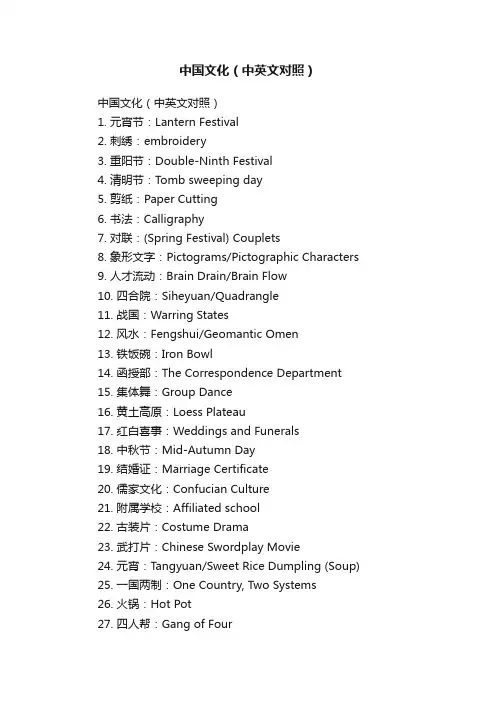
中国文化(中英文对照)中国文化(中英文对照)1. 元宵节:Lantern Festival2. 刺绣:embroidery3. 重阳节:Double-Ninth Festival4. 清明节:Tomb sweeping day5. 剪纸:Paper Cutting6. 书法:Calligraphy7. 对联:(Spring Festival) Couplets8. 象形文字:Pictograms/Pictographic Characters9. 人才流动:Brain Drain/Brain Flow10. 四合院:Siheyuan/Quadrangle11. 战国:Warring States12. 风水:Fengshui/Geomantic Omen13. 铁饭碗:Iron Bowl14. 函授部:The Correspondence Department15. 集体舞:Group Dance16. 黄土高原:Loess Plateau17. 红白喜事:Weddings and Funerals18. 中秋节:Mid-Autumn Day19. 结婚证:Marriage Certificate20. 儒家文化:Confucian Culture21. 附属学校:Affiliated school22. 古装片:Costume Drama23. 武打片:Chinese Swordplay Movie24. 元宵:Tangyuan/Sweet Rice Dumpling (Soup)25. 一国两制:One Country, Two Systems26. 火锅:Hot Pot27. 四人帮:Gang of Four28. 《诗经》:The Book of Songs29. 素质教育:Essential-qualities-oriented Education30. 《史记》:Historical Records/Records of the Grand Historian31. 大跃进:Great Leap Forward (Movement)32. 《西游记》:The Journey to the West33. 除夕:Chinese New Year’s Eve/Eve of the Spring Festival34. 针灸:Acupuncture35. 唐三彩:Tri-color Pottery of the T ang Dynasty/ The Tang Tri-colored pottery36. 中国特色的社会主义:Chinese-charactered Socialist/Socialist with Chinese characteristics37. 偏旁:radical38. 孟子:Mencius39. 亭/阁:Pavilion/ Attic40. 大中型国有企业:Large and Medium-sized State-owned Enterprises41. 火药:gunpowder42. 农历:Lunar Calendar43. 印/玺:Seal/Stamp44. 物质精神文明建设:The Construction of Material Civilization and Spiritual Civilization45. 京剧:Beijing Opera/Peking Opera46. 秦腔:Crying of Qin People/Qin Opera47. 太极拳:Tai Chi48. 独生子女证:The Certificate of One-child49. 天坛:Altar of Heaven in Beijing50. 小吃摊:Snack Bar/Snack Stand51. 红双喜:Double Happiness52. 政治辅导员:Political Counselor/School Counselor53. 春卷:Spring Roll(s)54. 莲藕:Lotus Root55. 追星族:Star Struck56. 故宫博物院:The Palace Museum57. 相声:Cross-talk/Comic Dialogue58. 下岗:Lay off/Laid off59. 北京烤鸭:Beijing Roast Duck60. 高等自学考试:Self-taught Examination of Higher Education61. 烟花爆竹:fireworks and firecracker62. 敦煌莫高窟:Mogao Caves63. 电视小品:TV Sketch/TV Skit64. 香港澳门同胞:Compatriots from Hong Kong and Macao65. 文化大革命:Cultural Revolution66. 长江中下游地区:The Mid-low Reaches of Yangtze River67. 门当户对:Perfect Match/Exact Match68. 《水浒》:Water Margin/Outlaws of the Marsh69. 中外合资企业:Joint Ventures70. 文房四宝(笔墨纸砚):"The Four Treasure of the Study" "Brush, Inkstick, Paper, and Inkstone"71. 兵马俑:cotta Warriors/ Terracotta Army72. 旗袍:cheongsam。
中国文化知识(英汉对照)
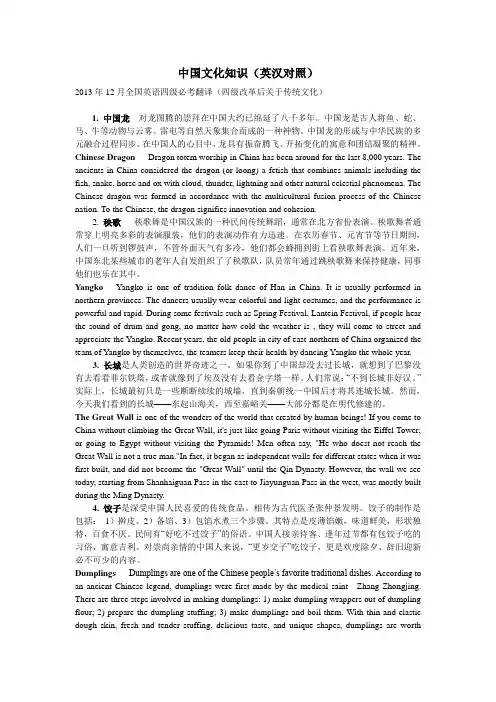
中国文化知识(英汉对照)2013年12月全国英语四级必考翻译(四级改革后关于传统文化)1. 中国龙对龙图腾的崇拜在中国大约已绵延了八千多年。
中国龙是古人将鱼、蛇、马、牛等动物与云雾、雷电等自然天象集合而成的一种神物。
中国龙的形成与中华民族的多元融合过程同步。
在中国人的心目中,龙具有振奋腾飞、开拓变化的寓意和团结凝聚的精神。
Chinese Dragon Dragon totem worship in China has been around for the last 8,000 years. The ancients in China considered the dragon (or loong) a fetish that combines animals including the fish, snake, horse and ox with cloud, thunder, lightning and other natural celestial phenomena. The Chinese dragon was formed in accordance with the multicultural fusion process of the Chinese nation. To the Chinese, the dragon signifies innovation and cohesion.2. 秧歌秧歌舞是中国汉族的一种民间传统舞蹈,通常在北方省份表演。
秧歌舞者通常穿上明亮多彩的表演服装,他们的表演动作有力迅速。
在农历春节、元宵节等节日期间,人们一旦听到锣鼓声,不管外面天气有多冷,他们都会蜂拥到街上看秧歌舞表演。
近年来,中国东北某些城市的老年人自发组织了了秧歌队,队员常年通过跳秧歌舞来保持健康,同事他们也乐在其中。
Yangko Yangko is one of tradition folk dance of Han in China. It is usually performed in northern provinces. The dancers usually wear colorful and light costumes, and the performance is powerful and rapid. During some festivals such as Spring Festival, Lantein Festival, if people hear the sound of drum and gong, no matter how cold the weather is , they will come to street and appreciate the Yangko. Recent years, the old people in city of east-northern of China organized the team of Yangko by themselves, the teamers keep their health by dancing Yangko the whole year.3. 长城是人类创造的世界奇迹之一。
中国传统文化经典名人故事【中英对照】
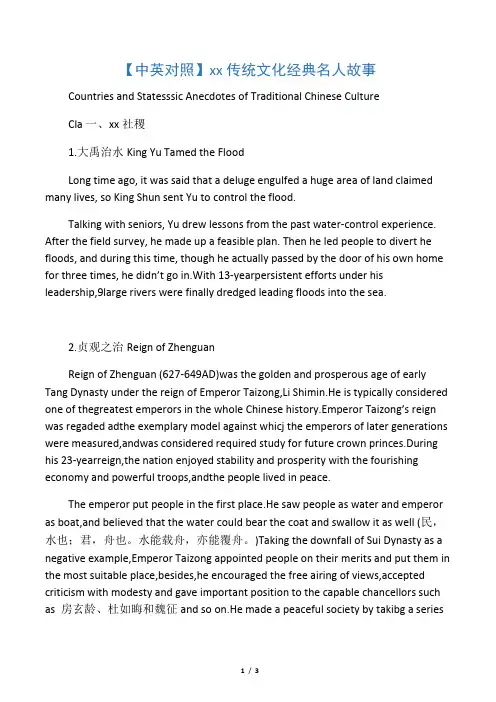
【中英对照】xx传统文化经典名人故事Countries and Statesssic Anecdotes of Traditional Chinese CultureCla一、xx社稷1.大禹治水King Yu Tamed the FloodLong time ago, it was said that a deluge engulfed a huge area of land claimed many lives, so King Shun sent Yu to control the flood.Talking with seniors, Yu drew lessons from the past water-control experience. After the field survey, he made up a feasible plan. Then he led people to divert he floods, and during this time, though he actually passed by the door of his own home for three times, he didn’t go in.With 13-yearpersistent efforts under his leadership,9large rivers were finally dredged leading floods into the sea.2.贞观之治Reign of ZhenguanReign of Zhenguan (627-649AD)was the golden and prosperous age of early Tang Dynasty under the reign of Emperor Taizong,Li Shimin.He is typically considered one of thegreatest emperors in the whole Chinese history.Emperor Taizong’s reign was regaded adthe exemplary model against whicj the emperors of later generations were measured,andwas considered required study for future crown princes.During his 23-yearreign,the nation enjoyed stability and prosperity with the fourishing economy and powerful troops,andthe people lived in peace.The emperor put people in the first place.He saw people as water and emperor as boat,and believed that the water could bear the coat and swallow it as well (民,水也;君,舟也。
中华民族优秀传统文化英语作文
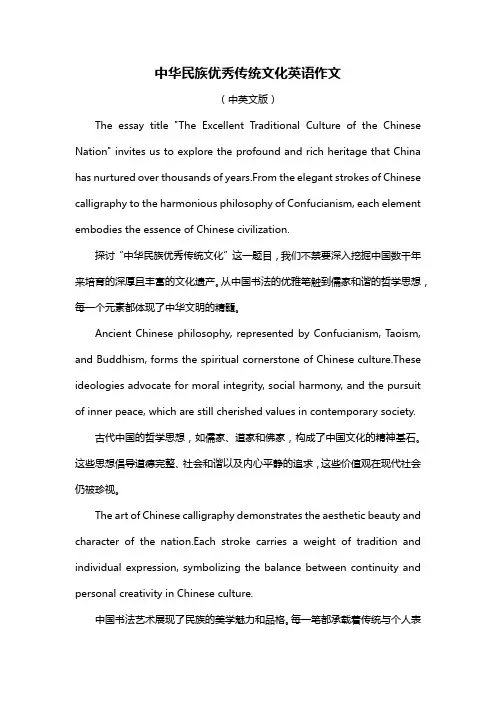
中华民族优秀传统文化英语作文(中英文版)The essay title "The Excellent Traditional Culture of the Chinese Nation" invites us to explore the profound and rich heritage that China has nurtured over thousands of years.From the elegant strokes of Chinese calligraphy to the harmonious philosophy of Confucianism, each element embodies the essence of Chinese civilization.探讨“中华民族优秀传统文化”这一题目,我们不禁要深入挖掘中国数千年来培育的深厚且丰富的文化遗产。
从中国书法的优雅笔触到儒家和谐的哲学思想,每一个元素都体现了中华文明的精髓。
Ancient Chinese philosophy, represented by Confucianism, Taoism, and Buddhism, forms the spiritual cornerstone of Chinese culture.These ideologies advocate for moral integrity, social harmony, and the pursuit of inner peace, which are still cherished values in contemporary society.古代中国的哲学思想,如儒家、道家和佛家,构成了中国文化的精神基石。
这些思想倡导道德完整、社会和谐以及内心平静的追求,这些价值观在现代社会仍被珍视。
The art of Chinese calligraphy demonstrates the aesthetic beauty and character of the nation.Each stroke carries a weight of tradition and individual expression, symbolizing the balance between continuity and personal creativity in Chinese culture.中国书法艺术展现了民族的美学魅力和品格。
中国传统文化(中英文)
中国传统文化一、“传统节日”单词预热vocabulary work烹调cooking cuisine鱼肉满架well stocked with fish and meat象征意义symbolic significance农历lunar calendar阳历solar calendar端午节Dragon Boat Festival元宵节Lantern Festival清明节Pure Brightness Day重阳节Double Ninth Day放逐be exiled忠臣loyal minister糯米粽子glutinous rice dumplings wrapped in bamboo leaves 祭祀亡灵in memory of sb.龙舟比赛dragon boat races中秋节Mid Autumn Festival满月full moon月饼moon cake蜜饯preserved fruits豆沙bean paste蛋黄egg yolk海鲜seafood家禽poultry饺子dumplings八宝饭eight treasure rice米羹rice balls油条fried sticks麻花fried twisted stick炒面Chaomian叉烧包steamed bun with roast pork粥porridge芋头taro葱油饼pan-fried cake with sesame seeds and green onion有关春节的常用词放鞭炮let off firecrackers耍龙灯play the dragon lantern耍狮子play the lion dance拜年pay a new-year call三、实考题分析中国的传统节庆膳食除了在数量和质量上与平时有所不同之外,一些历史悠久、具有象征意义的食物也是节日必不可缺的伴侣。
Traditional holiday meals are different from everyday meals in terms of quantity and quality. In addition, some foods with a long history and symbolic significance are indispensable on these occasions.例如,我国的端午节是纪念古代诗人屈原的日子。
中国传统文化(英文版)
Sheng(笙)
Hsiao(箫)
Ditze(笛子)
Cheng(筝)
Pipa(琵琶)
Yangchin(扬琴)
Erhu(二胡)
Gehu(革胡)
Bangtze(梆子)
Large Drum(大鼓) Dingyin Ganggu ( 定 音 缸 鼓 ) Yunluo(云锣) Hsiangban(响板)
On one hand,Bamboo is one of the most pliable plants in the world.No matter how strong the wind is,bamboo will not be hurt by it. On another hand,bamboo is growing fast,though there are many animals treat bamboo as food,bamboo will never disappear.
Zodiac Paper-cut
Folk paper-cut
Spring Festival Paper-cut
Wind Instruments
(吹管乐器) (弹拨乐器)
Plucked Instruments
Stringed Instruments
(擦弦乐器)
Percussion Instruments
Let’s enjoy some pictures
Symbols of Chinese culห้องสมุดไป่ตู้ure
————唐装
Two different definitions
Chinese-style costume(中式服 装)
Dresses of the Tang Dynasty
中国传统文化(中英文)
中国传统文化一、“传统节日”单词预热vocabulary work烹调cooking cuisine鱼肉满架well stocked with fish and meat象征意义symbolic significance农历lunar calendar阳历solar calendar端午节Dragon Boat Festival元宵节Lantern Festival清明节Pure Brightness Day重阳节Double Ninth Day放逐be exiled忠臣loyal minister糯米粽子glutinous rice dumplings wrapped in bamboo leaves 祭祀亡灵in memory of sb.龙舟比赛dragon boat races中秋节Mid Autumn Festival满月full moon月饼moon cake蜜饯preserved fruits豆沙bean paste蛋黄egg yolk海鲜seafood家禽poultry饺子dumplings八宝饭eight treasure rice米羹rice balls油条fried sticks麻花fried twisted stick炒面Chaomian叉烧包steamed bun with roast pork粥porridge芋头taro葱油饼pan-fried cake with sesame seeds and green onion有关春节的常用词放鞭炮let off firecrackers耍龙灯play the dragon lantern耍狮子play the lion dance拜年pay a new-year call二、有关“介绍”的翻译•我很高兴向各位介绍中国的主要传统节日。
→I am very happy to have the opportunity to talk to you about major traditional Chinese holidays.表示“介绍情况”时,我们可以这样翻译:1.to share with you brief information•在此,我愿意向朋友们介绍这些方面的情况。
中国传统文化简介(中英双语)34页PPT文档
功夫之王—李小龙
Hong Kong kungfu star Bruce Lee's family plans to shoot a new movie about the martial arts and film legend to dispel the myths that have arisen since his death 33 years ago. Speaking at a gathering to mark the anniversary of the star's death in 1973, younger brother Robert Lee Chun-fai said the legend had never faded but few people knew the real Bruce Lee. He said this year the whole family decided to launch a book to mark his birthday in November and they would record a film to show the other side of Bruce, how he was growing up, his secrets and his philosophy from the never-seen perspective of his brothers and sisters. The film will be shot next year by JA Media in co-operation with brothers Robert and Peter and sisters Phoebe and Agnes, and is scheduled to air on the 35th anniversary of Bruce Lee's death in 2019. JA Media movie producer Stephen Shin Kei-yin said they would trawl the world to find the right actor to portray Lee
- 1、下载文档前请自行甄别文档内容的完整性,平台不提供额外的编辑、内容补充、找答案等附加服务。
- 2、"仅部分预览"的文档,不可在线预览部分如存在完整性等问题,可反馈申请退款(可完整预览的文档不适用该条件!)。
- 3、如文档侵犯您的权益,请联系客服反馈,我们会尽快为您处理(人工客服工作时间:9:00-18:30)。
莫逆之交:bosom friends总角之交:friendship between people who are friends since childhood一般作宾语,指儿时的朋友。
总角:古代未成年的人把头发扎成髻。
借指童年时期,幼年。
总角是八九岁至十三四岁的少年,古代儿童将头发分作左右两半,在头顶各扎成一个结,形如两个羊角,故称“总角”。
贫贱之交:friendship between people who are poverty-stricken and from humble circumstances杵臼之交:friendship between people who do not care about the financial condition and social status of each other 杵:舂米的木棒;臼:石臼。
比喻交朋友不计较贫富和身分。
君子之交:friendship between gentlemen小人之交:friendship between villains狐朋狗友:people who often gather together doing something meaningless and even illegal棋友/牌友/球友:people who often meet to play chess, poker, ball. etc.战友:people who get to know each other while serving in the same army unit普通老百姓交的朋友谓“布衣之交”;有钱人与没钱人交朋友谓“车笠之交”;在逆境中结交的朋友称“患难之交”;吃喝玩乐结交的朋友称“酒肉之交”;年岁差别大,行辈不同而交情深厚的朋友称“忘年之交”;幼年相交的朋友称“竹马之交”;交情深厚的朋友谓“肺腑之交”;亲密无间的朋友谓“胶漆之交”;生死与共的朋友谓“生死之交”;情投意合的朋友称“莫逆之交”;哪怕砍头也不改变友谊的朋友称“刎颈之交”;无意中相遇而结成的朋友称“邂逅之交”;在道义上互相支持的朋友称“君子之交”;只见过一次面,交情不深的朋友称“一面之交”;仅点头打招呼,感情不深的朋友称“点头之交”;平淡而浮泛交往的朋友称“泛泛之交”;见过面但不熟悉的人称“半面之交”;旧时结拜的兄弟姊妹称“八拜之交”;交友不嫌贫贱称“杵逆之交”;宝贵而有价值的交往称“金玉之交”。
儒家思想Confucianism儒家文化Confucian culture道教Taoism墨家Mohism法家Legalism佛教Buddhism孔子Confucius孟子Mencius老子Lao Tzu庄子Chuang Tzu墨子Mo Tzu孙子Sun Tzu象形文字pictographic characters《大学》The Great Learning《中庸》The Doctrine of the Mean《论语》The Analects of Confucius《孟子》The Mencius《孙子兵法》The Art of War《三国演义》Three Kingdoms《西游记》Journey to the West文房四宝the Four Treasures of the Study(笔墨纸砚)( brush ,ink Stick ,paper , and ink stone ) 《红楼梦》Dream of Red Mansions《水浒传》Heroes of the Marshes《山海经》The Classic of Mountains and Rivers《资治通鉴》History as a Mirror《春秋》The Spring and Autumn Annals《史记》Historical Records《诗经》The Book of Songs《易经》The Book of Changes《礼记》The Book of Rites《三字经》Three-character Scriptures八股文eight-part essay五言绝句five-character quatrain七言律诗seven-character octave(一)Chinese characters were initially meant to be simple pictures used to help people remember things. After a long period of development, it finally became a unique character system that embodies phonetic sound,image, idea, and rhyme at the same time. The writing system, which was extremely advanced in ancient times, began with inscriptions on bones and tortoise shells, and these are regarded as the original forms of Chinese characters. Afterwards, Chinese characters went through numerous calligraphic styles: bronze inscriptions, official script, regular script, cursive script, running script, etc. Chinese characters are usually round outside and square inside, which is rooted in ancient Chinese beliefs of an orbicular sky and a rectangular Earth. The five basic strokes of Chinese characters are “---“ (the horizontal stroke) “│” (the vertical stroke), “/”( the left-falling stroke), “\” (the right-falling stroke), and “乙” (the turning stroke).汉字是从原始人用以记事的简单图画,经过不断演变发展最终成为一种兼具音、形、意韵的独特文字。
现存中国古代最早成熟的文字是甲骨文,被认为是现代汉字的初形。
此后,汉字又经历了金文、隶书、楷书、草书、行书等不同的阶段。
汉字结构“外圆内方“,源于古人”天圆地方“的观念。
汉字有五种基本笔画,即:横、竖、撇、捺、折。
(二)Chinese Taoism Taoism first originated in China. The founder of Taoism is Laozi, a philosopher and thinker who lived in the late Spring and Autumn Period (770BC-476BC). Tao Te Ching whose authorship has been attributed to Laozi, is considered to be the main Taoist classic. Taoism advocates the value of a human being’s life, recommends thediscarding of all desires and worries from one’s mind, and encourages the cultivation of moral character and the nourishment of human nature. The following is an example of Laozi’s golden saying: The way that can be told of is not an unvarying way; the names that can be named are not unvarying names. It was from the nameless that Heaven and Earth sprang; The named is but the mother that rears the ten thousand creatures, each after its kind. Truly, only he that rids himself forever of desire can see the secret essences; He that has never rid himself of desire can see only the outcomes.道教是中国土生土长长的宗教。
创始人是春秋末期的哲学家、思想家老子。
道教以老子所著的《道德经》为主要经典。
道教主张“重人贵生”。
崇尚清静无为,修身养性。
“道可道,非常道。
名可名,非常名。
无名天地之始;有名万物之母。
故常无,欲以观其妙;常有,欲以观其徼”便是老子的至理名言。
(三)The Four Treasures of the Study The writing brush, ink stick, ink stone, and paper were requisite treasures in the study of the scholars of ancient China, and they are often referred to as the “Four Treasures of the Study.” The writing brush and ink stick have been used by the Chinese to write and paint since 5,000 years ago. In the Qin Dynasty (221BC---206BC), people already used feathers of different hardness and bamboo trunks to make brushes. During the Han Dynasty (206BC-220AD), man-made ink was used instead of natural ink. After paper was invented bythe Chinese, bamboo slips, wooden tablets, brocade and silk, which originally functioned as writing surfaces, gradually faded out. The ink stone was first developed with the use of writing brushes and ink. After the Song Dynasty (960AD---1279AD), the “Four Treasure of the Study” particularly referred to hubi, the writing brush produced in Huzhou, Zhejiang province; huimo, the ink stick produced in Huizhou, Anhui province; xuan paper, a kind of paper produced in Xuanzhou, Anhui province; and duanyan, the ink stone made in Zhaoqing, Guangdong province (Zhaoqing was earlier called Duanzhou). Indeed, the Four Treasures of the Study” have written the whole Chinese civilization, as it is.笔墨纸砚是中国古代文人书房当中必备的宝贝,被称为“文房四宝”。
